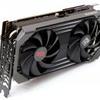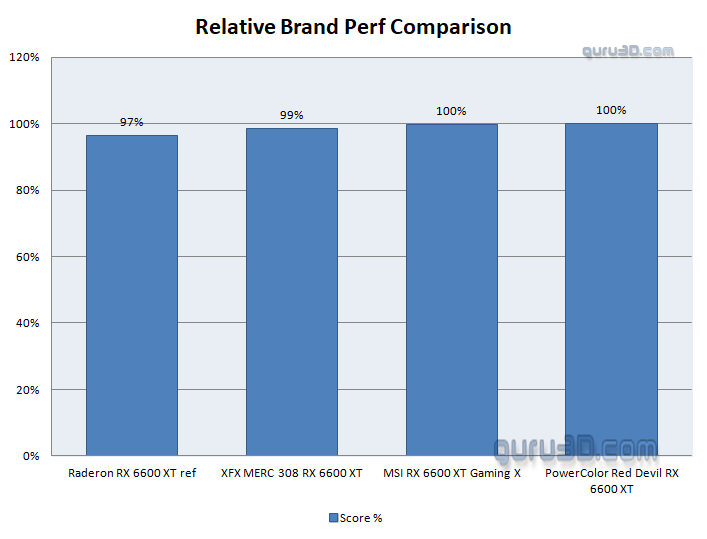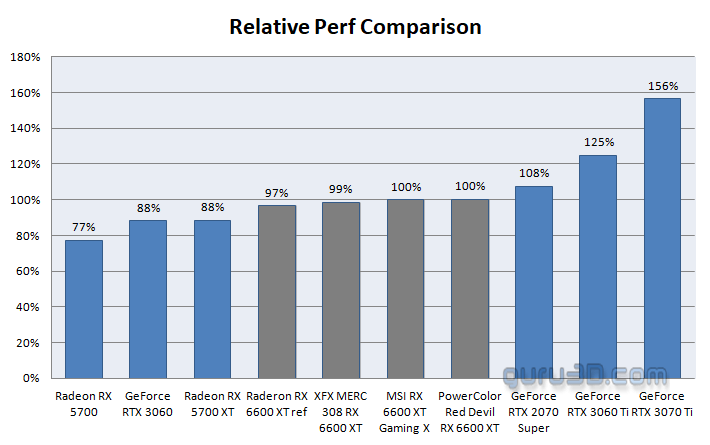Final words and conclusion
Final words
PowerColor delivers on their promise and hardware-wise have a winner on their hands, as I believe this product to be very good. It's true that the reference card costs 379,- so this card will be more expensive. The design is nice, and even in default performance mode, the card remains to be acoustically correct. Fan RPM climbs up a little bit at first where you can hear it a little bit, and then it settles at a lower rotational speed. During gaming, the system was really quiet. Next to that a silent BIOS option provides very consistent silent operation and consequently extremely good acoustic performance. But let's start with the generic conclusion for the 6600 XT product line as a starting point. It is clear that AMD has done an excellent job with NAVI23; the GPU performs as promised and perhaps a bit better; it is a legitimate gaming card in the Full HD and even WQHD domains. However, 379 USD for a graphics card that ranges from entry-level to mainstream level, oh bejeezus, how things have changed. Is it prohibitively expensive? Yes, we believe that is the case. The cards' performance is comparable or above that of the RTX 3060 and 5700 XT, but solely in terms of shading performance. When it comes to raw Raytracing performance, it is a notch slower than what the competition provides. Albeit FSR is now available to help a little bit, we can also not apprehend that AMD still has not implemented any form of machine learning super-sampling dedicated in hardware, much like NVIDIA offers Tensor cores. For reasons like RT perf and lacking MLAA, we cast doubt on how AMD is justifying that starting price of 379 USD. You can also argue that while the Infinity cache works most of the time, it's designed to be a workaround to fill an imperfection (128-bit memory bus) and the choice of a more affordable memory type (GDDR6 opposed to GDDR6X), the current AMD GPUs are very memory bandwidth deprived, even with GDDR6 at 16 Gbps, but more so due to the 128 -bit wide memory bus. And that's going to bite this product in the ass every time you get GPU limited, or the32MB L3 cache runs out and gets fewer hits.
FidelityFX Super Resolution
AMD has been implementing its own (in their belief) DLSS counterpart called FidelityFX Super-Resolution for a while. The supersampling and sharpening technology from AMD is available however the number of games that support is incredibly poor. As you have been able to see, we tested this at the latest iteration of Resident Evil as it's really the only AAA title that has support, and the increase in perf was okay at best combined with Raytracing.
Performance spread
If we compare a bit with cards that are in the same performance range then from top to bottom, the differences certainly are not perceptible, have a peek:
For this week we have three 6600 XT products lined up. Unfortunately, AMD does not supply a reference card, ergo we downclocked the 6600 XT entry towards reference levels. While these are not delivering precise values we estimate that the difference between reference and the factory tweaked models tested is roughly 3%. In between the three cards tested the performance differential is 1% or less.
If we look at the data in further detail, we can see something interesting. Specifically, AMD is aiming the 6600 XT against the GeForce RTX 3060, which has an MSRP of 329 USD and a similar feature set. AMD, on the other hand, has set an MSRP of 379 USD. The 3060 Ti, on the other hand, costs 399 USD. As a result, the Radeon RX 6600 XT is, in our perspective, competitively priced with the 3060 Ti and not 3060, despite being substantially less powerful. Also, and let me make this very clear, the 5700 reference card was 349,- and the reference XT 5700 model 399,- ... this is a series lower than that, 6600. So AMD price positioned the 6600 series at last year's 5700 series price level.
Cooling & acoustic
The Red Devil 6600 XT, like its larger siblings, produces excellent results even when subjected to demanding conditions, thanks to the dual-fan cooler. Because the card is so quiet, you'll have a difficult time hearing it if you try. Because the GPU beneath the hood generates 130W to 140W TGP and 160W TBP of heat in its default configuration, it is likely that the cooler has a thermal power design of 250W or more. It appears that 33-35 DBa levels under load are the sweet-spot and temperatures stick closer to the 60~65-degree Celsius range, these are all very acceptable values. Additionally, a board examination reveals that all-important components are linked to some sort of cooling. FLIR imaging reveals that the card is only barely leaking heat. In general, we are really satisfied with what we have observed.
Energy
Heat output and energy consumption are closely related to each other, as (graphics) processors and heat can be perceived as a 1:1 state; 250 Watts in energy consumption approaches close to 250 Watts in heat as output. This is the basis of TDP. AMD is listing the card at 160W, which is okay at best for a graphics card in the year 2021. We measure numbers slightly under the XT's advertised values; we measure the entire power consumption of the card to close in at 160~170 Watt, for the total card.
Coil whine
Coil squeal is present on the 6600 XT, just as it is on any other card these days, albeit to a lesser extent than usual. Is it a bothersome annoyance? It is, without a doubt, at a volume that is difficult to raise concerns. This type of noise would be muffled in a closed chassis and fade into the background. With an open chassis, on the other hand, you may hear coil whine/squeal. In some way or another, all graphics cards do this, especially when running at higher frame rates; this can be perceived.
Pricing
The 6600 XT is priced significantly higher than it should be, in our opinion, and we have already discussed this extensively. AIB devices will almost certainly exceed the 400 USD level, which makes little sense for a product geared at the Full HD monitor market that IMHO is price fighting against a 399 USD GeForce RTX 3060 Ti.
Tweaking
The RX 6600 XT likes more memory bandwidth. You can add it with a manual tweak, up to 18 maybe even 19.2 Gbps; Results will vary per board, brand, and even card due to cooling (GDDR6/GPU/VRM). GPU tweaking wise we'd reach a ~2700 MHz on this AMD Navi GPU. We had hoped for a little more, especially considering the large 20% power that can be enabled as extra. As always, all that tweaking and extra energy consumption will bring you maybe 5% extra performance at best (depending on your results and model graphics card). For our overclock to be successfully listed here, it needs to pass 4 game runs (different games) in 2560x1440 to be deemed stable.
Conclusion
PowerColor has a nice product on its hands; they have created something that is thermally sound, acoustically pleasing, and visually appealing, with the added plus of being dual-BIOS. Due to limitations in the memory subsystem due to AMD's product design, the company has chosen to include 32MB of L3 cache, which has allowed the card to perform flawlessly at that 1920x1080 resolution; however, L3 cache will always be a bypass and a short-cut solution to an issue that may recur in the future. When cache hits fail, performance will decrease as a result of the highly limited memory bus available on the system. Despite the fact that AMD's raytracing technology does not perform as well as its competitor's, it is still usable for "fooling around." While we do not believe FSR will be sufficient for most AAA games to make a significant enough difference in a low resolution, it is a fun option to have and to experiment with. If the price weren't so outrageous, it would still be an intriguing and gorgeous product in the 1920x1080 resolution; nevertheless, the price is a touch too high in this case. At the very least, the product would have had to be priced at or below $300 USD in order to be considered for inclusion. I recognize that you may disagree with me and engage in an argument with me. This graphics card (379 USD MSRP for the cheaper designed cards) will compete with the GeForce RTX 3060 Tiin price (399 USD), but the latter one is significantly faster. Overall, the Radeon RX 6600 XT series is a fun gaming card series that is exclusively focused on rasterized shading; at Full HD and even WQHD resolutions, the 32MB L3 cache performs wonders. You might want to play about with raytracing a little bit to see what occurs. The asking price, on the other hand, remains a key source of anxiety. You'll receive a dual-BIOS as well as a product that is silent, thermally cool, and elegant in appearance thanks to Powercolor's work on this tiny Demon.
- Sign up to receive a notification when we publish a new article.
- Or go back to Guru3D's front page.
- Hilbert, LOAD"*",8,1.



